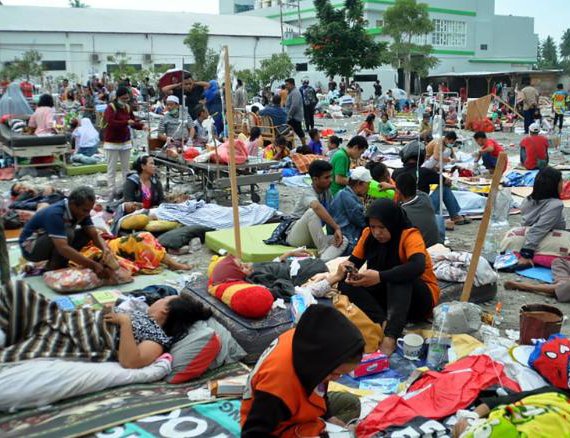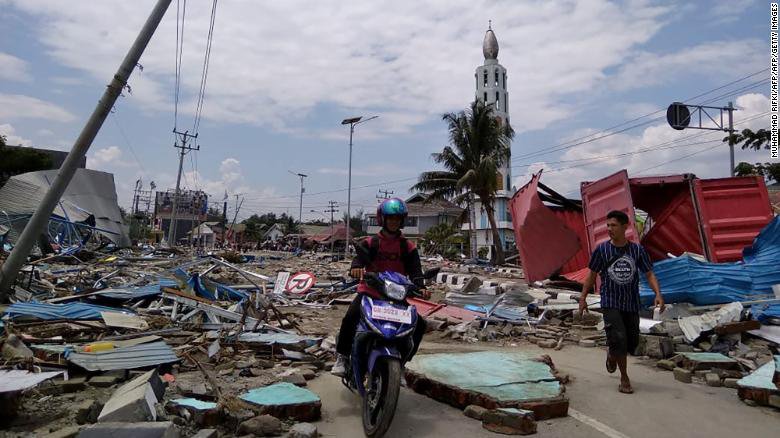
Rescue workers are hunting for survivors after a powerful earthquake hit the Indonesian island of Sulawesi and triggered a tsunami, killing at least 384 people.
After the 7.5-magnitude earthquake hit Friday, water smashed into buildings and swept away homes in the coastal city of Palu, home to 350,000 people.
More than 540 people are being treated in several local hospitals amid the massive destruction in Palu and 29 people are missing.
The death toll could climb in the coming days, Disaster Management Agency spokesman Sutopo Purwo Nugroho warned. Rescuers scrambled to reach the area to search for survivors buried under debris, Saturday, September 29.
Rescuers scrambled to reach the area to search for survivors buried under debris, Saturday, September 29.
The earthquakes collapsed buildings, cut power and covered roads in debris.
Emergency relief efforts were held up by the closure of the closest airport that was also damaged by the quakes.
On Friday, September 28, the Indonesian island of Sulawesi was hit by a series of earthquakes, triggering a tsunami as high as three meters. The first of the quakes was felt at 3 p.m. local time, 35 miles north of Palu, according to the United States Geological Survey.
On Friday, September 28, the Indonesian island of Sulawesi was hit by a series of earthquakes, triggering a tsunami as high as three meters. The first of the quakes was felt at 3 p.m. local time, 35 miles north of Palu, according to the United States Geological Survey.
A 7.5 magnitude tremor -- the largest shock recorded Friday -- triggered a tsunami that hit beaches in the cities of Palu and Donggala, officials said.
As of Saturday, September 29, at least 48 people were confirmed dead and hundreds injured. Medical team members treated patients in open ground outside a hospital in Palu the day after the quake.
As of Saturday, September 29, at least 48 people were confirmed dead and hundreds injured. Medical team members treated patients in open ground outside a hospital in Palu the day after the quake.
Rescuers scrambled to reach the area to search for survivors buried under debris, Saturday, September 29.
Electricity and communications have been cut off, making it difficult to assess the damage in Palu and nearby fishing community of Donggala, Sutopo said.
"It is not just the people in the large urban areas. There are a lot of people also living in remote communities who are hard to reach" Jan Gelfand, head of the International Red Cross in Indonesia, told CNN.
With Palu airport closed, relief workers have to make their way to Palu by road. Sulawesi is one of the biggest islands in the world and the drive from the nearest airport is around 10-12 hours. "We already have people en route but you never know what damage there is to the road infrastructure."
In Palu, authorities are still urging residents to not go inside their homes and sleep away from buildings - fields, roads or yards because of the danger from aftershocks.
After a local hospital was damaged, medical staff opted to treat dozens of wounded residents just outside the building, Sutopo said.
Medical team help wounded residents outside a hospital in on Saturday. Medical team help wounded residents outside a hospital in on Saturday.
Dr. Komang Adi Sujendra, Director of Undata Hospital in Palu was seeking help from the public following the quake.
"At the moment, in our hospital, electricity is out all over Palu, roads are cracked, the phone network doesn't work," he said in a video posted on Twitter. "We are hoping for any help." "We need tents, medicine, canvas, nurses ..."
An air traffic controller who stayed behind to make sure a passenger airplane took off was among the dozens of victims.
Three quakes of 4.9 and larger magnitudes were recorded up to three hours before the tremor near Palu, the USGS said. The tremor triggered a tsunami that hit beaches in the cities of Palu and Donggala, officials said.
The shaking of the 7.5-magnitude tremor was "severe" and the likely damage following the quake was considered "moderate to heavy," the USGS said.
A series of aftershock quakes were reported in the aftermath of the quake, including a 5.8 magnitude tremor just 12 minutes later.
An early tsunami warning had been issued by the Indonesian meteorological agency, but was later lifted after the agency ascertained that the water had receded.
A resident is seen beside the collapsed brick wall of her house at Tobadak village in Central Mamuju, western Sulawesi province, on September 28 after a strong earthquake hit the area.
The quakes come a month after a trio of earthquakes hit several islands in the South Pacific and Indonesia, including Lombok, which is still recovering from the effects of an August 5 earthquake that killed more than 430 people.

Photo and news courtesy: CNN
- India Supported Construction Of Four Schools In Nuwakot
- Mar 19, 2021
- Nepal Denies Permission For Third Phase Trial Of Vaccine Against COVID-19
- Aug 31, 2020
- Messi Can Only Cancel Barcelona Contract If €700 Million Release Clause Is Paid, La Liga Confirms
- Aug 31, 2020
- India To Carry Out Study On Kathmandu-Raksaul Railway
- Aug 28, 2020
- COVID-19: 1,351 Personal Of Nepal Police Infected
- Aug 28, 2020















